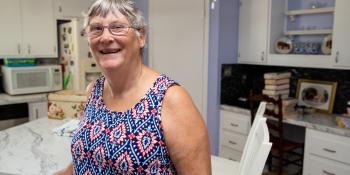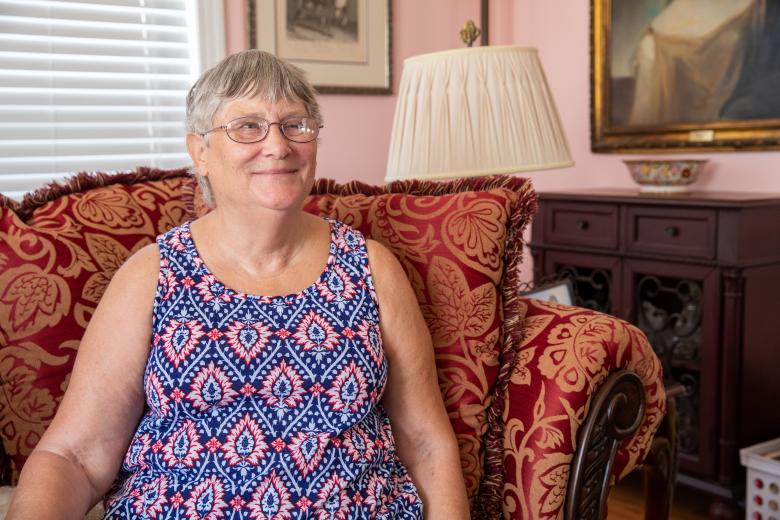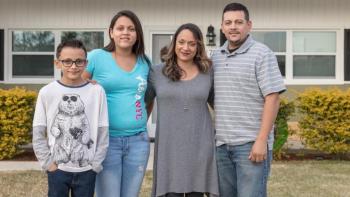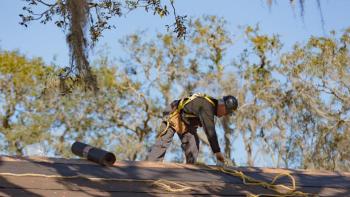
A Florida veteran stands strong after Hurricane Irma
As Hurricane Irma was preparing to make landfall on the U.S. Gulf Coast in September 2017, Sara was scrambling to escape it.
While trying to evacuate her house in Naples, Florida, she ended up face-to-face with the hurricane after stepping outside to load her car. The wind, with gusts reaching 150 miles per hour, pushed Sara off the porch. She fell headfirst onto the concrete driveway.
When she came to nearly 16 hours later, Sara was 700 miles from home. Neighbors had driven through the night to get her to a Veterans Affairs hospital in north Georgia. Doctors there said Sara would not walk on her own again. Her family encouraged her to look into an assisted living facility.
But through perseverance and daily physical therapy, Sara returned home four months later — and walked in on her own two feet.
Significant damage after the storm
Her sense of accomplishment was short-lived as she scanned the scene. In the wake of the storm, the house had been “red-tagged,” a FEMA designation meaning that a structure is too dangerous to inhabit. Her home also had been burglarized in her absence.
“At least it’s still standing,” Sara consoled herself as she crossed the threshold. She likened the damage to the blows her body had taken, and she refused to give up on it — just as she had refused to give up on herself. “No matter how battered it was,” Sara says, “it was home.”

Home now had a 5-feet-by-18-feet hole in the roof, and the carport and porch had been torn off. Water had seeped in during the hurricane, as well as during every Florida afternoon rainstorm since, causing floors to buckle, electrical outlets to short and mold to flourish.
There was plenty of work, but Sara’s fixed income meant she had few options. She turned to — and was subsequently turned away from — every avenue for assistance she could think of.
It wasn’t until sharing her struggles with a fellow veteran that she learned about Habitat’s hurricane disaster recovery efforts. Her friend encouraged her to apply. “What’s the worst that could happen?” he said.
Habitat offers a hand
On a Thursday, Sara made an appointment with Habitat for Humanity of Collier County. The next day, she was approved.
That Saturday, much to her surprise, a crew from Habitat knocked on her door to begin the rebuilding. “I didn’t know what to expect,” says Sara, who admits she had braced herself for another rejection, “but it’s turning out to be a miracle.”
After identifying the emergency repairs necessary to make Sara’s home safe again, the crew prioritized their work.
They took off the blue tarp, which had served as the home’s sole protection against the elements for eight months, and put on a new roof. They replaced missing and waterlogged insulation and a washing machine fried by an electrical surge. Next, they’ll install new window frames, siding and gutters. The repairs meet improved code standards and help make the home more resilient against future storms.
Sara has been overwhelmed by the commitment and kindness. “It really was one of these life-affirming things,” she says, “to know there are still good people left in this world.”
The support has inspired Sara to pay it forward. She is busy helping older neighbors navigate permitting and bidding processes so they can rebuild. She puts her green thumb to use teaching neighbors how to garden, returning a sense of normalcy to their ravaged yards.
“Habitat was, in my sea of despair, the light coming out of the darkness, the hand that was extended to help me and hold onto me,” Sara says. “This is my way of giving back, for all the people who didn’t turn their backs on me.”

